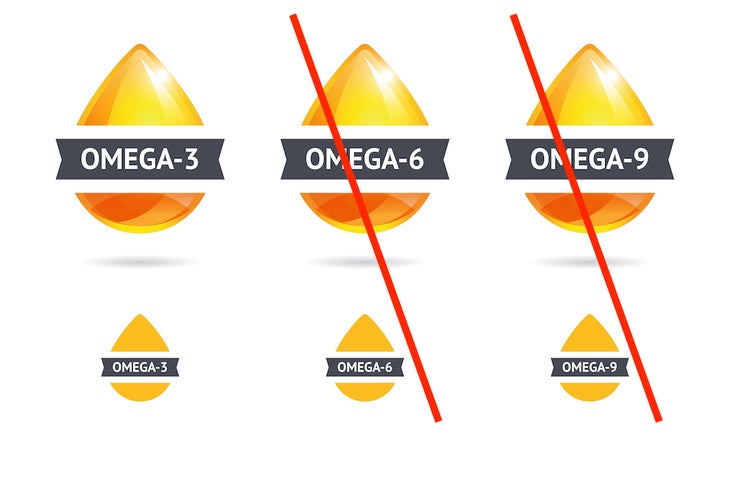Heading out the door? Read this article on the new Outside+ app available now on iOS devices for members! Download the app.

Women seem to fear fat, but it’s a nutrient required for normal body function. The right kind of fat in the correct amounts can actually benefit your physique.
One way to get the right fat is through fish oil, a rich source of omega-3 fatty acids. It can reduce the risk of heart disease as well as reduce inflammation and prevent blood clots on arterial walls. Fish oil also supports eye, hair, skin and joint health. It’s also been shown that omega-3 foods, supplementation and regular exercise can slow the cellular aging process. And if you are a hard-training woman who works out multiple days a week, it’s also important to know fish oil can help prevent muscle breakdown.
The omega-3 family of fatty acids includes eicosapentaenoic acid (EPA) and docosahexaenoic acid (DHA). Omega-3 fatty acids are found primarily in fatty cold-water fish such as salmon, sardines, mackerel and herring. You also can find plant-based sources of omega-3s. Foods like walnuts, flaxseed and hemp and oils like canola and soy are some good choices. However, plant-based omega-3s go through a conversion process once they are consumed, so you don’t receive the full health benefits from them. Many foods such as eggs, milk, soy milk, margarine and yogurt are fortified with plant-based omega-3s. These fortified foods are typically not a good value because the level of supplementation is so low.
If you’re concerned you might not be consuming enough omega-3s daily, worry no more. You can supplement with fish-oil capsules. Listed below are three simple suggestions on how to choose the right fish-oil supplement.
3 Tips for Selecting the Appropriate Fish-Oil Supplement
Be a Label Detective

Make sure you read your Supplement Facts label. You should aim for 1,000 to 1,200 milligrams of omega-3s in the form of EPA and DHA. The label may say it contains 1,000 milligrams of fish oil, but that doesn’t mean it’s all in the form of EPA and DHA. Oftentimes, the omega-3s in the form of EPA and DHA may be as low as 150 to 200 milligrams, so be sure to look at the EPA and DHA amounts in the supplement facts on the label to know how much you’re getting.
Look Out for Omega-6s and Omega-9s

Surprisingly, you don’t need extra omega-6s and omega-9s in your supplement. The standard American diet already includes sufficient amounts of these fatty acids.
Some supplements add them to make it seem like you’re getting extra health benefits, but remember, omega-6s induce a pro-inflammatory response in the body. Don’t purchase a supplement that has those two omegas listed on the label.
Know Your Fish

While eating fish is a healthy choice, it can be difficult to consume sufficient omega-3 from eating fish alone. Additionally, not all fish are created equal — the most commonly eaten fish in the US aren’t exactly high in omega-3. Research has shown two 3 1/2 ounce servings of oily or fatty cold water fish is ideal for optimal heart health, but what kind of fish is this? Mackerel, salmon, herring and tuna top the omega-3 list.
Supplementation, in combination with proper seafood in your diet, is the ideal way to hit the appropriate omega-3 dose. Analyze your personal fish consumption and supplement from there.
How to Avoid “Fishy Burps”
- Take fish oil with food or before bedtime.
- Note liquid fish oil supplements quickly oxidize after opening and become rancid, causing that fishy taste to repeat on you. Softgels can also oxidize after an extended period of time, but are far more durable.
- Start with half the recommended dosage and gradually increase your dose. Give your body time to adjust.
- If one brand causes GI distress, try another brand. Some are “odorless” or “lemon flavored” and may digest easier.
- Try taking the dose with a meal that contains some fat to alleviate any discomfort.
- Purchase a high quality fish oil. Look at the Supplement Facts label to see how many softgels you’ll need to take to get 1,000 to 1,200 mg of omega-3; quality brands will have a higher concentration and require fewer softgels.
Supplementing with fish oil is a solid way to support an amazing machine — our body. Ideally, your body should obtain the nutrients it needs from your diet first. However, if you’re not getting the recommended amount through the food you eat, supplements can help. Remember, when shopping for an omega-3 fish-oil supplement, read the label and aim for 1,000 to 1,200 milligrams of omega-3s in the form of EPA and DHA. As with any supplement, if you have any pre-existing health issues, always check with your health-care adviser before taking any supplement.